- Home
- Peter Tremayne
The Subtle Serpent Page 5
The Subtle Serpent Read online
Page 5
Fidelma was interested at once.
‘Explain, Odar,’ she invited.
‘The mooring ropes, sister. Both fore and aft. The mooring ropes have been cut.’
Ross immediately led the way to the nearest oak bollard at the bow of the ship.
‘I left the ropes hanging in place so that you might see them for yourself,’ Odar explained. ‘I only noticed them myself when we were making fast a short while ago.’
Ross bent to where the strong flax cordage was fastened to the bollard and began to haul up the loose end which dangled down the side of the ship. It finished after about twenty feet or so, its end frayed into numerous strands. Fidelma took it from Ross’s hands and examined it carefully. The end had certainly been cut; hacked at by an axe judging from the way the pieces of flaxen rope had frayed. The thickness of the ship’s rope would confirm that only an axe could have cut it.
‘And what of the other mooring line?’ she asked Odar. ‘Is it the same as this?’
‘Yes, but you may see for yourself, sister,’ the sailor replied.
Fidelma thanked him for bringing the matter to her attention and went to perch herself on the taffrail. She stared moodily into the middle distance. Ross, by her side, examined her with a bewildered expression. He knew when it was best to remain silent.
Finally, Fidelma let out a sigh.
‘Let us sum up what we know,’ she began.
‘Which is not much,’ interposed Ross.
‘Nevertheless … first, we know that this is a merchant ship from Gaul.’
Ross nodded emphatically.
‘True. It is about the only thing that we can be certain of. I can swear that her construction is in keeping with the methods of the ship-builders of Morbihan.’
‘Which then presumes that she might have sailed from a port in that area?’
‘True again,’ Ross agreed. ‘Merchant ships, like her, often trade along our coast.’
‘They bring mostly wine and barter for goods from our merchants?’
‘That is so.’
‘The fact that there was no cargo on board might suggest that this ship had already delivered her cargo to an Irish port?’
Ross rubbed his chin.
‘Perhaps.’
‘I’ll grant you your “perhaps”. However, if she had a cargo when it was removed, and we presume that it was removed at sea, then to remove kegs of wine would be a difficult task. Would it not be a simpler supposition that she had already unloaded the casks of wine in an Irish port and was then returning to Gaul either without a cargo or with a cargo more easily removed at sea?’
‘There is a logic in that suggestion,’ Ross admitted.
‘Then I think we are progressing,’ Fidelma said triumphantly. ‘Now, let us reflect on what else we know. There is blood in this ship. Some of the blood was below deck. There was also some blood of more recent shedding on a strip of linen found caught in the rigging and smeared on the handrail below the rigging. That blood, though dried, is not old and was probably spilt within the last twelve to twenty-four hours. The blood could belong to a crew member or …’ she paused and tried not to think of Eadulf, ‘or to a passenger.’
‘Why not to one of the raiders?’ demanded Ross. ‘One of those who removed the cargo or the crew?’
Fidelma reflected on the point and then conceded the possibility.
‘Why not? And, of course, who is to say that there was a raider or raiders? Perhaps the crew themselves took the cargo and left their vessel.’ She held up her hand as Ross started to point out the objections to such an idea. ‘Very well. The main point is that the blood seems to have been spilt during the time of the crew’s disappearance; at the moment when whatever happened on board the ship took place.’
Ross waited while she reviewed the matter silently.
‘The ship’s fore and aft mooring ropes were severed, as if by an axe. From that we learn that she must have been moored against something, not merely anchored in a harbour for the anchor is still in place but the mooring ropes are cut. Why? Why not simply untie the mooring ropes? Was someone on board in a hurry to depart from somewhere? Or was the ship tied to another vessel and then cut adrift?’
Ross glanced admiringly at Fidelma as she conjured possibilities.
‘How long was she under view until we boarded her?’ she asked him abruptly.
‘I had noticed her about half an hour before Odar drew attention to her dangerous course. We took a further half an hour to close up and board her.’
‘This means that the ship might have been close to this shore when whatever took place. Do you agree?’
‘Why so?’
‘The ship could only have been attacked within the last twelve to twenty-four hours before we sighted her.’ She suddenly straightened. ‘You know this coast well, don’t you, Ross?’
‘I know it,’ he admitted, without boasting. ‘I have sailed these waters for forty years.’
‘Can you judge by the winds and tides what place this ship might have sailed from to the spot when you first sighted her?’
Ross looked at Fidelma’s excited features. He did not want to disappoint her.
‘It is difficult, even knowing the tides. The blustery winds are changeable and inconsistent.’
Fidelma’s mouth drooped in disappointment.
Seeing her dissatisfaction, he added hastily: ‘But I can, perhaps, calculate a good guess. I think it is safe to say that there are two probable places. The mouth of this bay or further around at the southern end of this peninsula. The tides from those points would certainly carry the ship in the direction of the spot we first saw her at.’
‘That gives us a wide area of territory to search.’ Fidelma was still not satisfied.
‘This friend to whom that book satchel belongs …’ Ross changed the subject, then hesitated. “This friends … was he a good friend?’
‘Yes.’
Ross caught the emotional tightness in her voice as she uttered the single syllable. He waited a moment and then said softly:
‘I have a daughter of your age, sister. Oh, she is on shore and married. Her mother lives with someone else. I do not pretend to have an understanding of women. One thing I know, my daughter’s husband was lost at sea. That same look of hurt and anguish in her eyes on the morning the news came to Ros Ailithir, I now see in your eyes.’
Fidelma drew herself up defensively with a snort of irritation.
‘Brother Eadulf is simply a friend of mine, that is all. If he is in trouble, I will do what I can to help him.’
Ross nodded imperturbably.
‘Just so,’ he said quietly. She knew he was not fooled at all by her protest.
‘And at the moment,’ Fidelma continued, ‘I have other things to do. My duty is now to the Abbess Draigen. I may be several days at the abbey here before I can spend time searching. And what will I be searching for?’
‘Of course, your duty comes first,’ Ross assured her. ‘However, if it would help you, sister, while you are ashore at the abbey, I could take my barc and sail to the points I have indicated to see if there is any sign of a solution to this mystery. I will leave Odar and another man to keep an eye on this vessel and you may call on them should you need to.’
Fidelma’s face flushed. Then, with an abrupt movement, she bent forward and kissed the old seaman on the cheek.
‘Bless you, Ross,’ her voice had a catch which she could not disguise.
Ross smiled awkwardly.
‘It is nothing. We’ll sail on the early morning tide and return within a day or two, no longer. If we find anything …’
‘Come and tell me first.’
‘Even as you say,’ agreed the sailor.
Across the darkening waters of the inlet they heard the sounding of a bell.
‘Time for me to go to the abbey.’ Fidelma moved forward to the rail of the ship. She paused and glanced quickly across her shoulder at Ross. ‘God watch over your voyage, Ross.’ Her expression
was serious. ‘I do fear that there is some evil human agency at work here. I would not want to lose you.’
Chapter Four
‘And now, sister, I presume that you would like to inspect the corpse?’
Sister Fidelma started in surprise at Abbess Draigen’s suggestion. They were emerging from the abbey’s refectory in which most of the community of The Salmon of the Three Wells had taken the evening meal together.
Night had already settled over the tiny community and the buildings were shrouded in gloom although lamps had been lit in strategic places among the buildings to aid the sisters. It was another cold night and already a frost lay white over the ground, almost like a covering of snow. The wood fires were smoking among the abbey buildings. So far as Fidelma had been able to discern, there were a dozen buildings centred around a granite paved courtyard, in which a high cross had been erected. On one side of the courtyard was a cloister which fronted a tall wooden building, the duirthech or oak house, which was the abbey chapel. In fact, the majority of the buildings were wooden constructions, mainly built of oak timbers. The surrounding countryside was replete with oaks. There were also a few buildings of stone. Fidelma presumed these to be store rooms. Dominating all these buildings, and situated at one end of the duirthech, was a squat tower with stone foundations but wooden upper floors.
The abbey of The Salmon of the Three Wells was not unusual from many that Fidelma had seen in the length and breadth of the five kingdoms. There were, however, no outer walls such as at the main abbey complexes like Ros Ailithir. She had gathered, during the meal at which some conversation was allowed, unlike other houses where a lector usually intoned passages from the Gospels, that only fifty sisters constituted the community. Under the direction of the Abbess Draigen, one of the main devotions of the community was the keeping of a water-clock and the recording of the passing of time. The abbey, it seemed, was also proud of its library and some of the sisters spent their time in copying books for other communities. It was a quiet backwater, engaged in no more controversial work than study and contemplation.
‘Well, sister,’ inquired the abbess again, ‘do you want to see the corpse?’
‘I do,’ Fidelma agreed. ‘Though I am surprised that you have not yet buried it. How many days is it since it was discovered?’
The abbess turned from the door of the refectory and led the way across the courtyard towards the wooden chapel.
‘Six days have passed since the unfortunate was taken out of our well. Had you been longer in your arrival then we would, of course, have had to bury the corpse. However, as it is winter, the weather has been cold enough to retain the body for a while and we have a cold place for food storage under the chapel, a subterraneus, where we have placed the body. There are reputed to be several caves under the abbey buildings. But, even in these conditions, we could not have kept it forever. We have arranged to bury the body in our abbey cemetery tomorrow morning.’
‘Have you discovered the identity of the unfortunate?’
‘I am hoping that you will solve that matter.’
The abbess led the way through the cloisters, along the stone-paved corridor, passing the chapel doors, to the entrance of a small building made of rough-hewn granite blocks whose walls were built in the dry stone method, simply laid one on top of another. It was an appendage built on the side of the wooden tower. This stone building, which also connected with the tower, was apparently a store room and the pungent aroma of stored herbs and spices caught at Fidelma’s senses making her momentarily breathless. However, it was a pleasing, refreshing odour.
Abbess Draigen crossed to a shelf and took up a jar. She then took, from a pile, two squares of linen and soaked them with the liquid from the vessel. Fidelma inhaled the piquant odour of lavender. Solemnly, Abbess Draigen handed her the impregnated square of cloth.
‘You will need this, sister,’ she advised.
She led the way to a corner of the room where a flight of stone steps descended. They wound down into a cave which stretched about thirty feet in length, was twenty feet wide and whose naturally arched ceiling rose ten feet or more. Fidelma noticed what at first seemed to be some scratch marks on the entrance arch and then realised that it was the etched outlines of a bull; no, not a bull. It was more like a calf. The Abbess Draigen noticed her examination.
‘This place was once used in pagan worship, so we are told. The well which Necht blessed, for instance. There are a few remains from ancient times such as this scratching of a cow or some such animal.’
Fidelma silently acknowledged the reception of this information. She noticed another series of stairs ascending into the darkness just beyond the arched entrance.
‘Those lead directly up to the tower of the abbey,’ explained the abbess before Fidelma could frame the obvious question. ‘It is where we house our modest library and, at the top of the tower, our pride … a water-clock.’
They passed on into the cave itself. It was deathly cold. Fidelma reasoned that the subterraneus must be below sea level at this point. The cave was lit. She saw at once that the flickering light came from four tall candles at the far end.
Fidelma did not need to be told what it was that was lying under the shroud of linen on what appeared to be a table whose four corners were marked by the candles. The outline was easily recognisable except that the body seemed foreshortened. She approached cautiously. There was not much else in the cave. Some boxes were stacked against one wall and nearby were rows of amphorae and earthen containers, whose faint odours identified them as being used for storing wine and spirits.
In spite of the cold, Abbess Draigen was right. She did need the piece of lavender-impregnated cloth. While herbs and other scented plants had been strategically placed around the body, there was no mistaking the bitter stench that rose from the already decomposing corpse. Fidelma involuntarily caught her breath and raised the linen to her nostrils. Winter chill or not, the corpse was reeking with putrefaction.
Abbess Draigen, standing on the other side of the corpse, smiled thinly, her face half hidden by her own lavender-impregnated cloth.
‘The burial service will be performed at first light tomorrow, sister, that is if you do not require the corpse further for your investigation. The sooner it is done, the better.’ It was a statement rather than a question.
Fidelma did not answer but, bracing herself, she drew back the cloth from the body.
No matter how many times Fidelma encountered death, and violent death was no stranger td her, she always felt an abhorrence at the savagery of it. She always tried to look at corpses as an abstract, tried not to think of them as once living, sentient beings who had loved, laughed and enjoyed life. She compressed her lips firmly and forced herself to look down at the white rotting flesh.
‘As you will see, sister,’ the abbess pointed out unnecessarily, ‘the head has been hacked off. Thus we have no means of identifying the unfortunate.’
Fidelma’s eyes had immediately gone to the wound above the heart.
‘Stabbed first,’ she said, half to herself. ‘The slight bruising shows that the wound was not made after death. Stabbed in the heart and then decapitated afterwards.’
Abbess Draigen watched the young dálaigh with an impassive expression.
Fidelma forced herself to examine the severed flesh around the neck. Then she pulled back and looked at the body as a whole.
‘A young woman. Scarcely beyond the age of choice. I would hazard that she was no more than eighteen. Perhaps younger.’
Her eye caught a discolouration of the flesh around the right ankle. She frowned and examined it more closely.
‘Was this where she was tied to the well rope?’ she demanded.
Abbess Draigen shook her head.
‘The sisters who found the corpse said it was hanging by the left ankle and tied with rope.’
Fidelma turned her attention to the left ankle and saw faint marks and indentations on it. Indeed, such marks looked more consist
ent with rope burn and there was no bruising, showing that the rope had undoubtedly been placed after death. She turned her attention back to the right ankle again. No, this mark had been made during life. And it did not look as though a rope or cord had made such a mark. It was a regular circle around the leg, a band of discolouration of two inches in depth. The skin had clearly been marked while it was still living flesh.
She turned her attention to the feet. The soles were padded with hardened skin and there were innumerable cuts and sores on them showing that the owner, in life, had not led a pampered existence and probably had not worn shoes much. The toenails were unkempt and several of them were cracked and broken. And curiously, under the nails, there were dirt deposits. There had been an attempt to clean the body but this dirt seemed ingrained and was curiously red in texture, like a deep red clay that permeated into the very skin of the toes themselves.
‘I presume that the body has been washed since it was removed from the well?’ Fidelma asked, glancing up.
‘Of course.’ The abbess seemed irritated by the question. It was the custom to wash the body of the dead while waiting burial.
Fidelma made no further comment but turned her attention to the legs and the torso. These could tell her nothing except that, in life, the girl had a well-proportioned body and limbs. She next turned her attention to the hands. Fidelma controlled her surprise for the hands did not seem to balance the image of the feet. They were soft, without callouses, the fingernails were clean and manicured. She saw that the right hand had a strange blue stain on it covering the side of the little finger and the edge of the hand. The stain also occurred on the thumb and forefinger. She examined the other hand but there was no such identical staining there. The hands were not the hands of someone accustomed to manual work. Yet this seemed to contrast totally with the feet.
‘I was told that the corpse was clutching some items. Where are they?’ Fidelma inquired after a while.
The abbess shifted her weight from one foot to another.

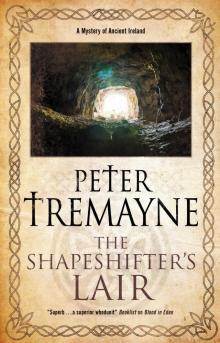 The Shapeshifter's Lair
The Shapeshifter's Lair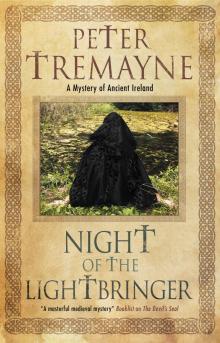 Night of the Lightbringer
Night of the Lightbringer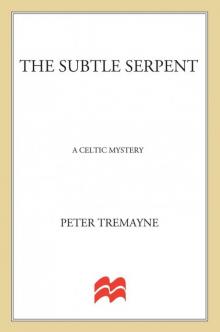 The Subtle Serpent
The Subtle Serpent Smoke in the Wind
Smoke in the Wind Island of Shadows
Island of Shadows The Morgow Rises!
The Morgow Rises! A Prayer for the Damned sf-17
A Prayer for the Damned sf-17 Behold a Pale Horse
Behold a Pale Horse Shroud for the Archbishop
Shroud for the Archbishop The Banshee (sister fidelma)
The Banshee (sister fidelma) The Curse of Loch Ness
The Curse of Loch Ness Whispers of the Dead
Whispers of the Dead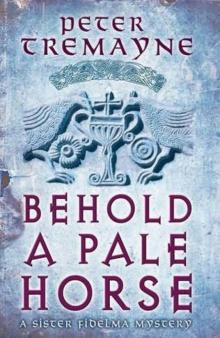 Behold a Pale Horse sf-22
Behold a Pale Horse sf-22 Suffer Little Children
Suffer Little Children The Spider's Web
The Spider's Web Sanctuary (sister fidelma)
Sanctuary (sister fidelma)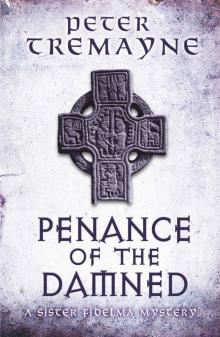 Penance of the Damned (Sister Fidelma)
Penance of the Damned (Sister Fidelma) Absolution by Murder
Absolution by Murder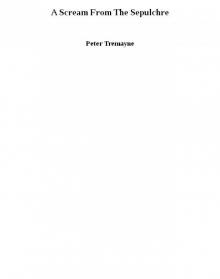 A Scream From The Sepulchre
A Scream From The Sepulchre The Dove of Death sf-20
The Dove of Death sf-20 Absolution by Murder sf-1
Absolution by Murder sf-1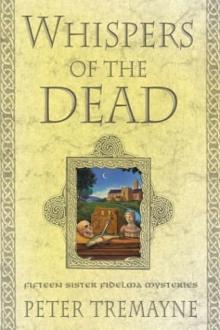 Whispers of the Dead sf-15
Whispers of the Dead sf-15 The Subtle Serpent sf-4
The Subtle Serpent sf-4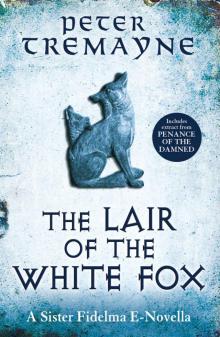 The Lair of the White Fox (e-novella) (Kindle Single)
The Lair of the White Fox (e-novella) (Kindle Single)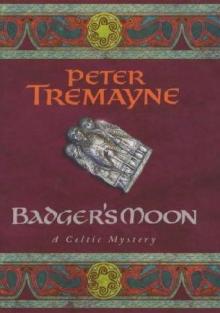 Badger's Moon sf-13
Badger's Moon sf-13 The Monk Who Vanished
The Monk Who Vanished Master of Souls sf-16
Master of Souls sf-16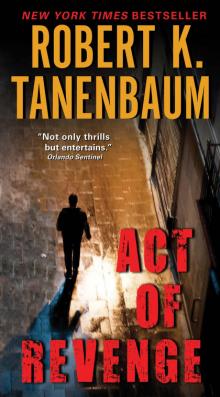 Act of Mercy sf-8
Act of Mercy sf-8 Valley of the Shadow
Valley of the Shadow Act of Mercy
Act of Mercy Dancing With Demons sf-18
Dancing With Demons sf-18 Suffer Little Children sf-3
Suffer Little Children sf-3 The Leper's Bell
The Leper's Bell Master of Souls
Master of Souls Hemlock at Vespers sf-9
Hemlock at Vespers sf-9 The Haunted Abbot sf-12
The Haunted Abbot sf-12 23- The Seventh Trumpet
23- The Seventh Trumpet The Spider's Web sf-5
The Spider's Web sf-5 Valley of the Shadow sf-6
Valley of the Shadow sf-6 Bloodmoon
Bloodmoon Hemlock at Vespers: Fifteen Sister Fidelma Mysteries
Hemlock at Vespers: Fifteen Sister Fidelma Mysteries The Council of the Cursed
The Council of the Cursed The Dove of Death
The Dove of Death The Leper's bell sf-14
The Leper's bell sf-14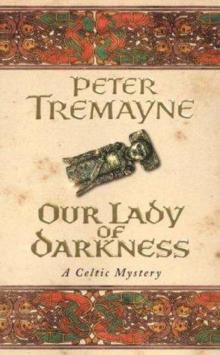 Our Lady of Darkness sf-10
Our Lady of Darkness sf-10 The Council of the Cursed sf-19
The Council of the Cursed sf-19 The Second Death (Sister Fidelma Mysteries)
The Second Death (Sister Fidelma Mysteries) The Fiery Devil
The Fiery Devil Dancing With Demons
Dancing With Demons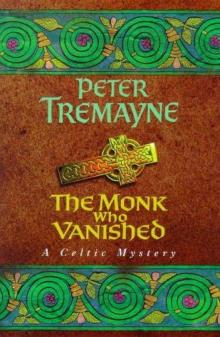 The Monk Who Vanished sf-7
The Monk Who Vanished sf-7 Our Lady of Darkness
Our Lady of Darkness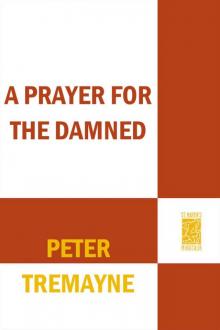 A Prayer for the Damned
A Prayer for the Damned Smoke in the Wind sf-11
Smoke in the Wind sf-11 An Ensuing Evil and Others
An Ensuing Evil and Others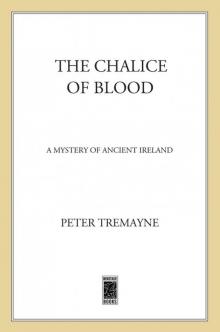 Chalice of Blood
Chalice of Blood